|
|
St.
Jerome. |
|
|
St.
Jerome. |
(The following is based in part on: L. Dysinger, Psalmody and Prayer in the Writings of Evagrius Ponticus, (Oxford University Press, 2005)
 |
FOR the details of Evagrius life we are largely dependent on his disciple, the bishop Palladius, who devotes a chapter of his Lausiac History to his master and occasionally mentions him elsewhere in that work. Palladius tells us little concerning the first half of Evagrius’ life. Born in Ibora, Pontus in 345 or 346, Evagrius’ was raised in a family that was not only Christian, but clerical: his father was a chorbishop.[1] Completely self-effacing in his own writings, Evagrius never mentions his youth or early academic training; however the style of his writing and occasional classical citations suggest that he was familiar with pagan classics and classical rhetoric.[2] Evagrius was in his mid to late twenties when (St.) Basil of Caesarea ordained him lector,[3] and he remained a member of Basil’s clergy until the latter’s premature death in 379: he thus spent nine years or less in Basil’s company.
|
|
The Death of
Basil |
MANY writers have speculated that Evagrius’ later choice of the monastic life owed something to the influence of Basil’s ascetical theology, or that Evagrius may have had first-hand experience of Basil’s monastic foundations. However Palladius gives no hint of monastic inclinations during this stage in Evagrius’ life, and it is probably significant that neither Evagrius nor any of his his biographers describe him as a ‘monk’ at this period.[4] Basil’s unexpected death emotionally shattered the thirty-three year-old Evagrius, who fled from Caesarea without warning or explanation, as he later wrote apologetically to friends in his Epistula Fidei. This letter is especially interesting, since it is the earliest text from Evagrius’ pen we possess.[5] In it he explains that in the aftermath of the psychological shock that accompanied Basil’s death he was overcome by ‘a longing for divine teachings and their attendant philosophy’ (Ep. fid. 1.11-13).
THE search for these ‘divine teachings’ led him to Constantinople, to Basil’s friend, (St.) Gregory Nazianzen, ‘a vessel of election and a deep spring […] Gregory, the mouth[piece] of Christ’(Ep. fid. 1.17-19). In the spring of 379 Gregory had been given charge of the small orthodox congregation in predominantly-Arian Constantinople. Evagrius may have reached Constantinople quite soon after Gregory’s arrival, perhaps only a few months later.[8] Gregory ‘took note of his fitness, and ordained him deacon’.[9] It is quite possible that Gregory refers to Evagrius Ponticus in his Testament of 381, alluding to Evagrius’ invaluable assistance and support during the turbulent period surrounding Gregory’s installation as Archbishop of Constantinople by the Emperor Theodosius:
|
To Evagrius the deacon who labored and strove together with me, and who so often proved his good will, I render thanks before both God and men.[10] |
Εὐαγρίῳ τῷ διακόνῳ͵ πολλά μοι συγκαμόντι καὶ συνεκφροντίσαντι͵ διὰ πλειόνων τε τὴν εὔνοιαν παραστήσαντι͵ χάριν ὁμολογῶ καὶ ἐπὶ Θεοῦ καὶ ἐπ΄ ἀνθρώπων |
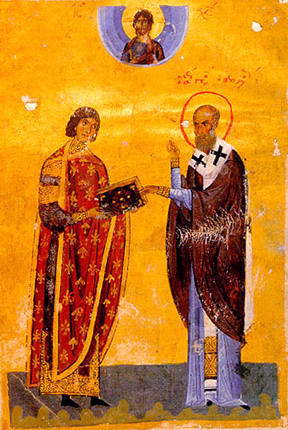 |
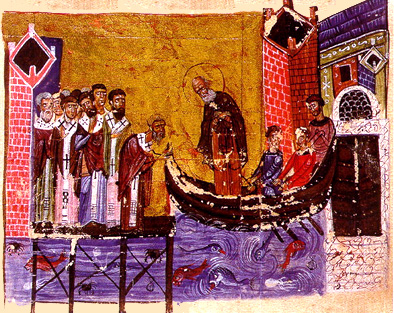 |
| Gregory Nazianzen presents his Theological Homilies, Illum. MS, Mt. Athos, Dionysiou, Cod. 61 1v. |
Gregory
Nazianzen leaves Constantinople. (Images modified) |
SEVERAL points should be noted concerning Evagrius’ stay in Constantinople:
FIRST, although he served Gregory Nazianzen as a deacon for less than two years, Gregory’s influence on him was both deep and long-lasting. Years later, Evagrius used titles of profound respect to describe Gregory as his revered teacher and a source of his spiritual doctrine.[11]
SECOND, Evagrius was present in Constantinople as a member of Gregory’s clergy when Gregory delivered his famous theological orations of 379-381. In his Epistula fidei Evagrius’ draws enthusiastically from Gregory’s Orations 30, 36, and 38. Therefore, if it was through Basil and Gregory Nazianzen that Evagrius became familiar with the teachings of Origen, he would have received from these two Cappadocians not an uncritical enthusiasm, but rather a highly critical and selective approach to Origen’s teachings, exemplified by their compilation of the Philokalia (not to be confused with the modern work of the same name!) from Origen’s De Principiis.
FINALLY, two famous churchmen, Gregory of Nyssa and Jerome, were also active in the circle around Gregory Nazianzen at this time, and it is probable that Evagrius encountered them in Constantinople. However there is no sugggestion that Gregory of Nyssa or Jerome took any notice of Evagrius at this time or ever recalled having met him; nor is there any certain evidence that Evagrius’ spiritual doctrine was directly influenced by either of them.[13]
AFTER Gregory Nazianzen’s unexpected resignation as archbishop in 381 during the Ecumenical Council of Constantinople, Evagrius was entrusted to Nectarios, Gregory’s successor. Evagrius demonstrated great rhetorical skill in Nectarios service, probably during the Council itself, ‘opposing all heresies with youthful vigor’.[14] Gregory Nazianzen left Constantinople before July of 381. Within a short time, perhaps less than a year, Evagrius also departed the imperial capital, never to return to Asia Minor. Nectarios’ eloquent, successful deacon was fleeing an impending love-affair with a noblewoman whose husband was a high civic official. Having been warned in an ‘angelic vision’[15] that the affair could cost him both his reputation and his life, Evagrius swore to obey the angel’s command to leave Constantinople immediately and ‘take heed for your soul’.[16] Despite misgivings upon awakening regarding the solemnity of an oath sworn in a vision, Evagrius remained in the city only long enough to pack his belongings, and took ship for Jerusalem.
ALTHOUGH the choice of Jerusalem as his destination does not appear to have been inspired by any particular interest in monasticism, he became acquainted soon after his arrival with the double monastery on the Mount of Olives founded by Melania the Elder and Rufinus, who eventually became his life-long friends. However their influence on him at this stage was insufficient to prevent a return to his former way of life; and for a time Evagrius wallowed in the life of an arrogant, self-indulgent cleric.[17] His conversion to monasticism came as the result of a mysterious febrile illness which lasted six months and left him weak and emaciated. Melania became concerned and encouraged him to tell her his whole story; after hearing it she promised to pray for his return to health if he would resolve to become a monk.[18] He agreed, was healed within a few days, and straightaway received the monastic habit.[19] Shortly thereafter he embarked for the Egyptian desert, undoubtedly after consulting with Melania and Rufinus, and probably with the intention of spending time in the company of monks and teachers whom they knew. [20]
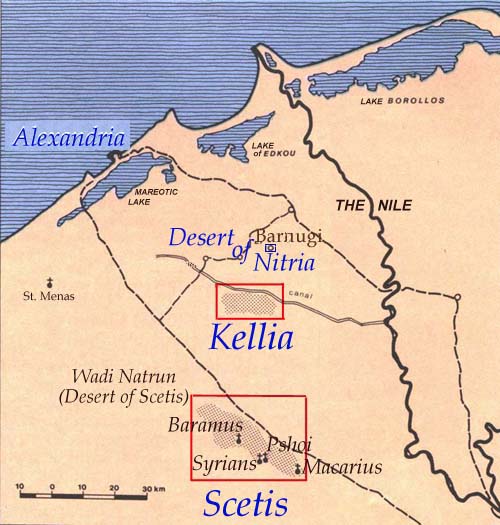 |
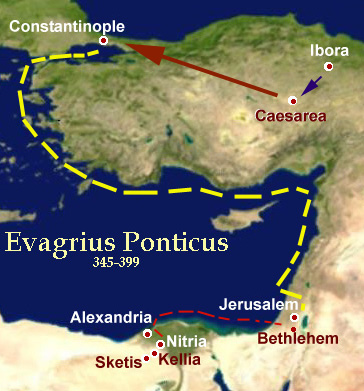 |
EVAGRIUS lived for two years in the monastic settlement of Nitria, 30 miles southeast of Alexandria. Following this initial cenobitic training he withdrew to the nearby hermit-colony of Kellia (‘the Cells’),[21] where he spent the remaining 15 years of his life. Evagrius’ biographers and his own writings particularly emphasize the formative spiritual training he received from the two famous Macarii. Macarius ‘the elder’ also called ‘the Egyptian’, was in the last years of his long life. He had founded the monastic community of Sketis, about 36 miles southwest of Nitria; and he maintained cells in both Kellia and Sketis. ‘The younger’ Macarius, also called ‘the Alexandrian’, was ‘the priest of Kellia’ and thus Evagrius’ monastic superior. Since the hermit life as was lived in Kellia did not preclude travel for the sake of spiritual advancement, Evagrius sought opportunities to learn from famous monks, including those who lived at a considerable distance. Thus in addition to regular visits to Macarius the Egyptian in Sketis,[22] Evagrius is known to have visited John of Lycopolis in the Thebaid; and it is possible that he also visited Didymus the Blind who lived on an island in the Mareotic Lake near Alexandria.[23]
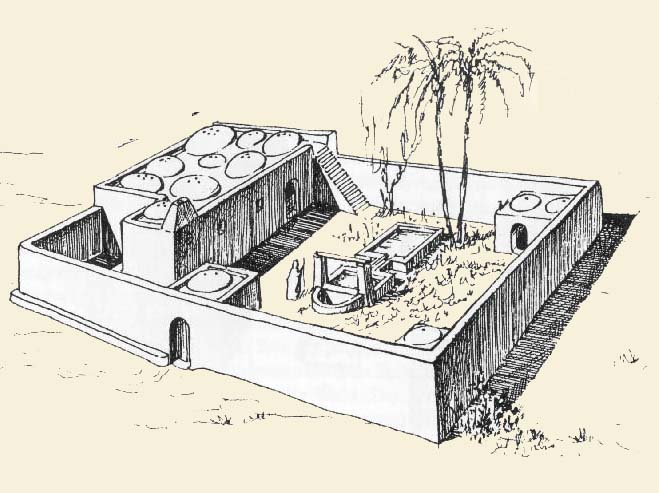 |
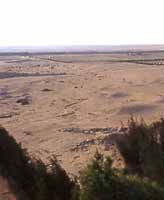 |
| Typical 6th c. mud- brick Hermitage at Kellia, (accom.1-3 monks) | Looking North from Scetis |
EVAGRIUS came to be known as a gifted abba, or spiritual teacher and guide; and as such he played a leading role in the intellectual ‘Origenist’ circle in Kellia. Its members included the four ‘tall brothers’, Ammonius, Euthymius, Dioscorus, and Eusebius, all of whom had been disciples of the famous Abba Pambo. Evagrius’ own disciples included the later bishops Palladius of Helenopolis and Heraclides of Cyprus. Evagrius and the Tall Brothers came to the attention of successive archbishops of Alexandria, who schemed at different times to add them to their clergy.[24] Of the four Tall Brothers, only Ammonius successfully resisted by cutting off his own ear and threatening to cut out his tongue unless Archbishop Timothy’s representatives desisted.[25] Around ten years later Evagrius employed the less drastic stratagem of flight against Timothy’s successor, Theophilus, who intended Evagrius to become Bishop of Thmuis. Evagrius fled to Palestine, probably to Melania and Rufinus, until Theophilus relented; then he returned to Kellia and eventually sent the archbishop an apologetic letter.[26] Socrates mentions that Evagrius later chided Ammonius for his immoderate act, and was in return rebuked by Ammonius with the observation that for one as skilled in rhetoric as Evagrius, to refuse episcopal ordination amounted to the same thing as cutting out one’s tongue.[27]
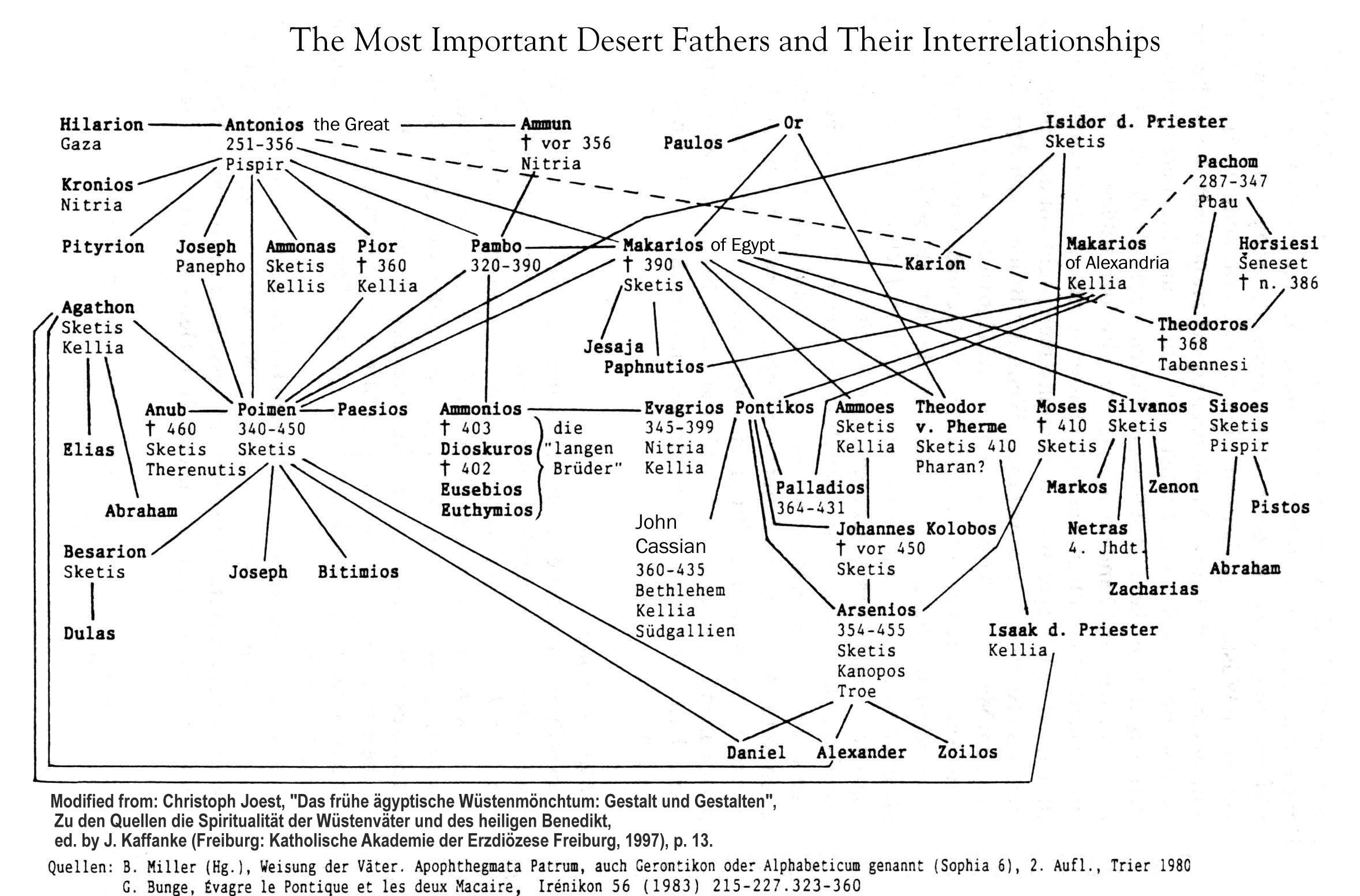 |
AS was not uncommon among the hermits of Kellia, Evagrius often received visitors at his hermitage, both monks and laypeople who sought his advice. The Coptic version of the Lausiac History describes this activity in some detail: he received monks on Saturdays and Sundays, and held discussions with them throughout the night; if any wished to speak privately with him he would see them individually in the morning.[28] He also received up to six or seven pilgrims each day, and any gifts they offered him were turned over to the steward who lived with him and managed his financial affairs. Evagrius supplemented the income from these gifts by copying manuscripts, a skill at which he evidently excelled.[29]
EVAGRIUS’ letters and the testimonies of his admirers reveal him to have been a discerning and compassionate spiritual guide, however his own personal asceticism was severe: his friend Rufinus described it as ‘incredible’.[30] He slept only a third of the night, spending the remainder of the night hours pacing in his courtyard, praying and meditating. During the afternoon he again paced in his courtyard in order to stay awake, and meditated on biblical texts. [31] In addition to the customary twelve psalms interspersed with prostrations and prayers which the desert monks offered twice a day as their ‘canonical’ office, Evagrius engaged in psalmody interspersed with prayers throughout the day. Palladius states that Evagrius ‘prayed 100 [psalms with] prayers each day’,[32] a practice which will be discussed in detail in Chapter 2 below. In obedience to the advice of Macarius the Alexandrian he mortified himself by nearly-continuous dehydration and he abstained entirely from fresh fruit and cooked food for fourteen years, although he was forced to mitigate this regime as his health deteriorated during the last two years of his life.[33]
EVAGRIUS’ life among the hermits of Kellia exemplifies that dynamic movement between contrasting extremes which also characterizes his spiritual theology. On the one hand his personal asceticism was extremely severe; yet in his capacity as abba he was gentle, and advised discretion. Similarly, in regard to his monastic confreres he was a leading figure in the ‘Origenist’ circle of monastic intellectuals which included Rufinus, Melania, and the Tall Brothers; yet he readily submitted to the spiritual and moral authority of rustic Copts, such as Macarius the Great, and he accepted without complaint public tests of humility which were regularly afforded both seasoned abbas and newcomers to the Egyptian desert.[34]
Despite the constant flow of visitors and the demands of his austere regime, Evagrius’ literary output was considerable. Some of his works were known locally in Nitria and Sketis and were probably disseminated there, while others, dedicated to patrons associated with the Mount of Olives community in Jerusalem, were probably copied and distributed through that monastery’s active scriptorium.[35] Rufinus translated several of Evagrius’ works into Latin,[36] thus making them available to a wider audience in the West.
EVAGRIUS died in 399 on the feast of Epiphany, just a few months before Theophilus of Alexandria’s Easter letter against the anthropomorphites precipitated the first Origenist crisis. Thus by a timely death Evagrius escaped Theophilus’ armed raids against the monks of Nitria and Kellia, and the exile which befell many of his confreres. During the hundred and fifty years which followed his death Evagrius’ writings inspired both criticism and admiration; but curiously, in the first decades following his death neither his critics nor his admirers bestowed on him the title (or epithet) ‘Origenist’. Jerome disliked Evagrius’ use of the term apatheia and was suspicious of Evagrius’ friendship with Rufinus; but he seems to have regarded Evagrius as a crypto-Pelagian, rather than a disciple of Origen.[37] Neither Palladius, Socrates, nor Sozomen associate Evagrius with the first Origenist crisis, which they otherwise recount in detail. Palladius’ failure to associate Evagrius with Origen is particularly surprising, since Palladius considered expertise in Origen a high attainment, almost a sign of sanctity; and he extols other desert fathers and mothers precisely because they pored over the famous Alexandrian’s works. [38] That Palladius does not praise his own teacher, Evagrius, in these terms suggests that Evagrius’ ‘Origenism’ was either less apparent or less a source of concern to his contemporaries than it was to those who later came to know his writings.
It was not until 553 that paraphrases and partial citations from Evagrius’ writings were condemned by the emperor Justinian; and it was not until some time later, perhaps as late as the seventh century, that Evagrius’ name began to appear regularly alongside that of Origen and Didymus in the list of anathemas.[39] These anathemas were occasioned in large measure by the exaggerated (and by then clearly heretical) christology and eschatology of certain sixth-century Palestinian monks who were fascinated with the writings of Origen and apparently also with Evagrius’ more obscure treatises, especially the Kephalaia Gnostica.[40] The acrimony aroused during this second Origenist controversy so stigmatized Evagrius’ memory that efforts were made not only to destroy his works, but to expunge his name from the apophthegmata and the early monastic histories. These efforts were largely ignored in the Syrian and Armenian churches, where Evagrius’ writings were cherished and where he is venerated as a saint. Evagrius’ memory has also been recently vindicated in the Roman Catholic Church. He is included in the most recent edition of Butler’s Lives of the Saints (Collegeville, 1997), with directions that his feast day of February 11 may be celebrated as an optional memorial.
|
|
[1] Palladius gives Evagrius’ age at the time of his death as 54. This was on the Feast of Epiphany in the same year Theophilus of Alexandria issued his Easter Letter against the anthropomorphites thus precipitating the first Origenist crisis; that is, 399 (Lausiac History 38.1 and 38.13).
[2] Wolfgang Lackner ‘Zur Profanen Bildung des Euagrios Pontikos’; Géhin, SC 340, p. 197, n.); and A. and C. Guillaumont, Traité Pratique, SC 171, pp. 682-683, n. Gabriel Bunge speculates that Evagrius may have studied at Cappadocian Caesarea (Briefe aus der Wüste, p. 20).
[3] This is a guess. Basil became bishop in 370; Palladius does not indicate when Evagrius joined Basil’s clergy.
[4] Scholars have occasionally described Evagrius as a ‘fugitive [Basilian] monk’: e.g. Bousset, Apophthegmata, p. 336; Hausherr, Traite de l’Oraison, p. 170. Bunge has pointed out that this interpretation is without foundation in the relevant sources: Briefe p. 22 and p. 95, n. 14.
[5] Bunge believes the Epistula fidei was composed in the first half of 381. It contains citations from Gregory Nazianzen’s Oration 36, which Bunge presumes to have been delivered between November 380 and May 381; however Evagrius does not make any mention of or allusion to the (Second Ecumenical) Council of Constantinople which took place in May 381, and in which he (Evagrius) played an active role: Palladius, Lausiac History 38.2, Bartelink, p. 194; Bunge, Briefe, p. 193.
[8] Evagrius borrows in his Epistula fidei from Gregory’s Oration 38, which is regarded by Gallay and Szmusiak to have been delivered in December, 379. If this dating is correct, and if Evagrius knew this text because he heard it preached, this suggests a terminus ad quem for his arrival in Constantinople.
[9] Palladius, Lausiac History 38.2
[10] Gregory Nazianzen, Exemplum Testamenti, PG 37.393. It is not certain, however, that Gregory is referring to Evagrius Ponticus in his Testament, since the name ‘Evagrius’ was fairly common. Gregory goes on to bequeath ‘Evagrius’, in thanks for his steadfast support, ‘a shirt, a tunic, two cloaks, and 30 gold pieces’.
[11] As noted above (Epistula fidei 1.17-19 ), Gregory Nazianzen is ‘a vessel of election […] a deep spring […] the mouth[piece] of Christ’. Elsewhere in his writings Evagrius calls him ‘our wise teacher’ (o( sofo\j h(mw=n dida/skaloj): Praktikos 89 (SC 171, p. 180) and Kephalaia Gnostica VI.51 (Greek fragment E20, Hausherr, ‘Nouveaux fragments’, p. 232).
[12] Typified by their compilation of the Philokalia from Origen’s De Principiis. Also noteworthy is Gregory’s account of the creation and fall in Oration 38.
[13] Numerous themes common to
both Evagrius and Gregoy of Nyssa can be adduced, but their significance has
yet to be determined. Thus, for example, I. Hausherr believes that Evagrius’
allusion to those ’who speak of one ignorance which has an end and another
without end’ (Praktikos 87, SC
171, p. 678: th=j
de\ a)gnwsi/aj th=j me\n ei)=nai pe/raj, th=j de\ mh\ ei)=nai/)
refers to ‘the authors of the Vitae
Mosis’, i.e.: Philo and Gregory of Nyssa (Hausherr, ‘Ignorance
infinie’, p. 360). Guillaumont, however, believes that this terminology
derives from Basil and Gregory in their controversy with Eunomius (Traité
Pratique, pp. 679-680). Lackner suggests that in Kephalaia
Gnostica III.76, V.12, and IV.68 Evagrius borrows from Gregory of
Nyssa’s use of Aristotle and Poseidonius (‘Zur profanen Bildung’, pp.
28-29); but Evagrius’ own familiarity with these ancient authors cannot be
excluded. This question belongs to the realm of conjecture, since as is
noted above, there are no clear citations of Gregory of Nyssa by Evagrius,
nor does Gregory of Nyssa ever mention Evagrius by name. As Bunge has
concluded, the whole question has yet to be thoroughly studied (Bunge, Briefe,
p. 21, n. 16).
In regard to Jerome, Evagrius never mentions him by name, except
perhaps elliptically and with some anxiety: for example, in disapproving
comments about monks who write or speak scornfully of others (Bunge,
Briefe, p. 93, n. 14) and in
his evident anxiety that the speculative Letter
to Melania not fall into the wrong hands (Evagrius, Letter
to Melania 17). Jerome criticized both Evagrius’ doctrine of apatheia
and Evagrius’ friendship with Rufinus and Melania in his Letter
to Ctesiphon, written about 15 years after Evagrius’ death; but
Jerome’s criticism gives no indication that he knew Evagrius personally.
[14] Palladius, Lausiac History 38.2, Bartelink, p. 194: lo/goij neanieuo/menoj kata\ pa/shj ai¸re/sewj.
[15] Palladius describes it as an angelic vision (a)ggelikh\ o)ptasi¿a) which followed prayer (Lausiac History 38.4, Bartelink, p. 194); while Sozomen (Ecclestiastical History 6.30, 9, Bidez (1995), p. 285) calls it a ‘fearful and saving vision’ which occurred in a dream during sleep, (kaqeu/donti au)t%½ fobera/n tina kaiì swth/rion o)nei¿ratoj oÃyin e)pipe/mpei to\ qeiÍon).
[16] Palladius, Lausiac History 38.2, Bartelink, p. 194: a)naxwreiÍj th=j po/lewj tau/thj kaiìì fronti¿zeij sou th=j yuxh=j.
[17] Palladius states that he reverted both in his clothing and his speech to what he had been before the vision, and was overcome with vainglory: ka)keiÍse pa/lin e)calla/sswn toiÍj i¸mati¿oij kaiìì e)n tv= diale/kt% e)ka/rou au)to\n h( kenodoci¿a, Palladius, Lausiac History 38.8, Bartelink, p. 198.
[18] E. White suggests that Melania considered the cause of Evagrius’ illness to be his failure to carry out his oath to obey the angel and ‘take heed for [his] soul’. Monastic life presented a way of carrying out this promise: Monasteries of the Wâdi ’n Natrûn, pp. 84-85.
[19] Although Palladius mentions only Melania in connection with Evagrius’ time in Jerusalem, Bunge emphasizes the significance of Evagrius’ relationship with the whole community on the Mount of Olives, and especially the role of Rufinus. Rufinus admired Evagrius (his translation of the Historia monachorum in Aegypto includes complimentary addenda praising Evagrius’ asceticism and erudition); and both he and Melania were the recipients of many of Evagrius’ letters. Bunge believes that it was from Rufinus that Evagrius received the habit, and that Palladius’ assertion that it was from Melania that he received the ceremonial ‘change of clothing’ (Lausiac History 38.8, Bartelink, p. 198: par ¹ au)th=j e)kei¿nhj methmfia/sqh) refers to her status as superior of the double monastery.
[20] Bunge believes that the ‘Anatolius’ to whom Evagrius dedicated his spiritual trilogy of Praktikos, Gnostikos, and Kephalaia Gnostica may have been a wealthy member of Rufinus’ monastic community: Briefe, pp. 32-36. He further suggests that the ‘Albinus’ whom Palladius describes as a close acquaintance of Evagrius in Egypt (Lausiac History 47.3, Bartelink, p. 226) may have been a relative of Melania, and the person to whom Melania originally entrusted Evagrius on his arrival in Egypt.
[21] White locates Kellia 10-11 miles southwest of Nitria on the route to Sketis: Monasteries of the Wâdi ’n Natrûn, p. 25
[22] These visits may partially account for the popularity of Evagrius’ writings among the monks of Sketis, his inclusion among their apophthegmata, and his occasional designation of himself as coming ‘from Sketis’, (Evagrius, Praktikos Prol. 1, SC 171, p. 482); however the latter designation may be explained by the fact that ‘the term “Scetis” is sometimes used in our sources to cover Nitria as well’: Chitty, The Desert a City, p. 12. It is possible that Evagrius also came into contact with John Cassian, who spent considerable time in Sketis, during these visits.
[23] Visits to Didymus may explain the otherwise-unattested and somewhat surprising statement in the anonymous Historia monachorum in Aegypto that Evagrius ‘frequenty visited Alexandria (polla/kij katelqwÜn ei¹j ¹Aleca/ndreian) to dispute with the philosophers’, (Historia monachorum in Aegypto 4.20.80).
[24] White believes that Timothy’s successful overtures to Eusebius and Euthemius took place in 375 or 376: Monasteries of the Wâdi ’n Natrûn, p. 131.
[25] Palladius, Lausiac History 11.1-4, Bartelink, pp. 50-53.
[26] Palladius, Lausiac History, Coptic ver., Amélineau p. 118. Evagrius’ apology to Theophilus is his Letter 13, discussed by Bunge in Briefe, p. 102 n. 158, p. 187; p. 340 n. 1-2.
[27] Socrates, Ecclesiastical History 4.23, 75-76, Hansen, p. 256.
[28] Palladius, Lausiac History, Coptic ver., Amélineau pp. 114-115.
[29] Evagrius is credited with the ability to ‘write the Oxyrinchus characters with a graceful hand’ (Palladius, Lausiac History 38.10, Bartelink, p. 200). In the nineteenth century Ehrhard suggested that the Euthalianus codex of the Pauline Epistles, which in a colophon bears the name ‘Evagrius’ and the date 396, is an example of Evagrius’ activity as a copyist and editor: Robinson, ed., ‘Euthaliana, Studies of Euthalius Codex H’, pp. 5-7, 100-102.
[30] Rufinus, Historia Monachorum 27.7.3, Schultz-Flügel, p. 364: ‘Hic ergo Evagrius incredibilis erat abstinentiae.’
[31] Palladius, Lausiac History, Coptic ver., Amélineau, p. 113.
[32] Palladius, Lausiac History 38.10, Bartelink, p. 200.
[33] The Coptic version of the Lausiac History (Amélineau, p. 112) mentions that he suffered from urinary tract stones, a condition which would have worsened - and indeed may have arisen - as a consequence of chronic dehydration.
[34] The Apophthegmata record Evagrius’ gentle answer to a rather sarcastic reproof by ‘the priest’ (probably Macarius the Alexandrian) on an occasion when Evagrius spoke: ‘We are quite aware, Abba, that had you remained in your own land you would doubtless be a bishop, in charge of many; but you now sit here [among us] as a foreigner,’ (Oi)/damen, a)bba=, o(/ti ei) $)=j e)n t$= xw/r# sou, kai\ e)pi/skopoj polla/kij kai\ kefalh\ pollw=n eiÕxej eiÕnai: nu=n de\ w(j ce/noj kaqe/z$ wÒde.). Evagrius, ‘untroubled’ (ou)k e)tara/xqh), cited Job in reply: ‘Indeed, Father; “I have spoken once, I will not do so a second time,” (Job 40:35).’ Apophthegmata Patrum, Greek Alphabetical Collection, Evagrius 7, PG 65.176.9-14.
[35] Bunge speculates on the possible relationship to the Mount of Olives community of several friends and patrons whose names appear in Evagrius’ works: Bunge, Briefe, pp. 32-37, 50-54.
[36] Jerome levels this as an accusation against Rufinus in Letter 133.3 (ad Ctesiphontem).
[37] Jerome, Letter 133.3 (ad Ctesiphontem); Dialogue Against the Pelagians, prologue.
[38] Palladius, Lausiac History 11.4, Bartelink, pp. 52-54 (of Ammonius); and Lausiac History 55.3, Bartelink, p. 252 (of Melania the Elder).
[39] The controversy surrounding Evagrius’ christology is discussed below in Chapter 6.2 and Appendix 1.
[40] The so-called ‘isochrist’ monks were accused of believing that all ‘will be the equal of Christ in the apokatastasis’. . The accusations against them are detailed in John of Scythopolis’ Life of Sabbas, especially chapters 36, 83-85, and 90. Guillaumont discusses the later fate of Evagrius’ writings and theology in Les ‘Kephalaia Gnostica’, pp. 124-166.
This Webpage was created for a workshop held at Saint Andrew's Abbey, Valyermo, California in 2001